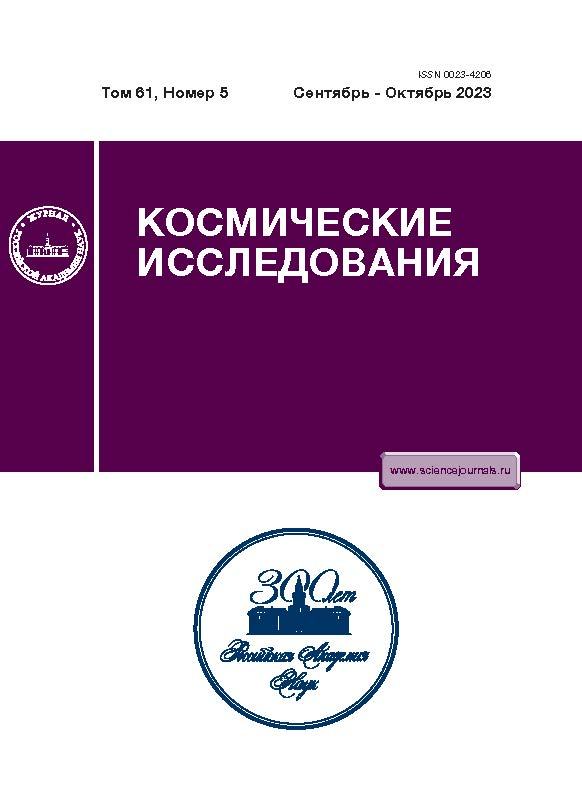Optimization of the Maneuver to Ensure a High Velocity of the Spacecraft Entry into the Atmosphere
- Autores: Konstantinov M.S.1
-
Afiliações:
- Research Institute of Applied Mechanics and Electrodynamics, Moscow Aviation Institute, Moscow, Russia
- Edição: Volume 61, Nº 5 (2023)
- Páginas: 355-359
- Seção: Articles
- URL: https://cardiosomatics.ru/0023-4206/article/view/672598
- DOI: https://doi.org/10.31857/S0023420623700188
- EDN: https://elibrary.ru/GSJEDU
- ID: 672598
Citar
Texto integral
Resumo
The transfer scheme that provides a parabolic entry of the spacecraft into the Earth’s atmosphere has been optimized. Such a maneuver can be of interest in experimental testing of the spacecraft reentry from the Moon or after interplanetary missions. It is assumed that the spacecraft is inserted into a low Earth orbit and is equipped with a chemical propulsion system and a limited-thrust engine, which should provide a maneuver to bring the spacecraft into the Earth’s atmosphere. The optimization criterion takes into account the characteristic velocity of the maneuver. The developed method of optimizing the transfer scheme and the spacecraft trajectory itself is based on the maximum principle. Single-revolution and multi-revolution transfer trajectories are analyzed. It is shown that for single-revolution trajectories there is an optimal time and an optimal angular distance of flight. Their values and the minimum characteristic velocity of the maneuver are evaluated. Unlike single-revolution trajectories, the characteristic velocity for multi-revolution trajectories monotonically decreases with increasing transfer duration. The dependence of the characteristic velocity on the transfer duration for single-, two-, three- and four-revolution trajectories is given. The transfer duration ranges in which it is advisable to use each type of trajectory are analyzed.
Sobre autores
M. Konstantinov
Research Institute of Applied Mechanics and Electrodynamics, Moscow Aviation Institute, Moscow, Russia
Autor responsável pela correspondência
Email: mkonst@bk.ru
Россия, Москва
Bibliografia
- Petukhov V., Ivanyukhin A., Popov G. et al. Optimization of finite-thrust trajectories with fixed angular distance // Acta Astronautica. 2022. V. 197. P. 354–367. https://doi.org/10.1016/j.actaastro.2021.03.012
- Petukhov V. Application of the angular independent variable and its regularizing transformation in the problems of optimizing low-thrust trajectories // Cosmic Research. 2019. V. 57. Iss. 5. P. 351–363. https://doi.org/10.1134/S001095251905006X
- Ivanyukhin A., Petukhov V. Optimization of multi-revolution limited power trajectories using angular independent variable // J. Optimization Theory and Applications. 2021. V. 191. Iss. 2. P. 575–599. https://doi.org/10.1007/s10957-021-01853-8
- Константинов М.С., Петухов В.Г., Тейн М. Оптимизация траекторий гелиоцентрических перелетов. М.: Изд. МАИ, 2015. 259 с.
- Petukhov V.G. One Numerical Method to Calculate Optimal Power Limited Trajectories. IEPC-95-221. M., 1995.
- Petukhov V.G. One Numerical Method to Calculate Optimal Power Limited Trajectories // 24th Intern. Electric Propulsion Conf. 19–23 Sept. Moscow. 1995. Art. ID. IEPC-95-221. 7 p.
- Петухов В.Г. Оптимизация межпланетных траекторий космических аппаратов с идеально-регулируемым двигателем методом продолжения // Косм. исслед. 2008. Т. 46. № 3. С. 224–237. (Cosmic Research. P. 219–232.)https://doi.org/10.1134/S0010952508030052
- Haberkorn T., Martinon P., Gergaud J. Low thrust minimumfuel orbital transfer: a homotopic approach // J. Guidance, Control, and Dynamics. 2004. V. 27. Iss. 6. P. 1046–1060.
- Петухов В.Г. Метод продолжения для оптимизации межпланетных траекторий с малой тягой // Косм. исслед. 2012. Т. 50. № 3. С. 258–270.
- Lyness J.N., Moller C.B. Numerical differentiation of analytic functions // SIAM J. Numer. Anal. 1967. Iss. 4. P. 202–210.
- Martins J.R.R.A., Sturdza P., Alonso J.J. The complexstep derivative approximation // ACM Transaction on Mathematical Software. 2003. V. 29. Iss. 3. P. 245–262.
Arquivos suplementares












